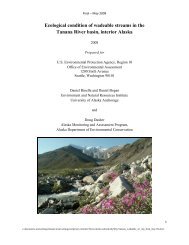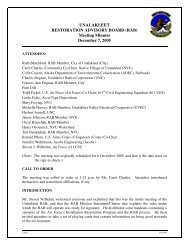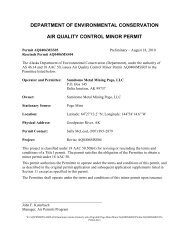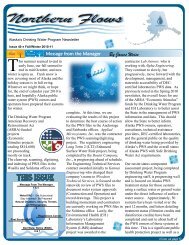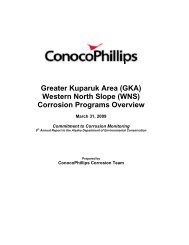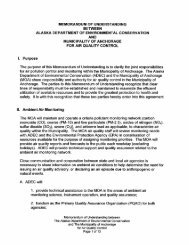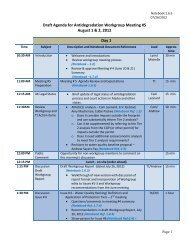2012 Ocean Ranger Guidebook Revision 3-7-12 - Alaska ...
2012 Ocean Ranger Guidebook Revision 3-7-12 - Alaska ...
2012 Ocean Ranger Guidebook Revision 3-7-12 - Alaska ...
You also want an ePaper? Increase the reach of your titles
YUMPU automatically turns print PDFs into web optimized ePapers that Google loves.
In May of 1965, a<br />
total of 15” of snow<br />
fell in Yakutat!<br />
<strong>20<strong>12</strong></strong> <strong>Ocean</strong> <strong>Ranger</strong> <strong>Guidebook</strong> 3-7-<strong>12</strong><br />
Yakutat<br />
Southeast <strong>Alaska</strong> Summer Weather<br />
The archipelago that is Southeast <strong>Alaska</strong> is part of the world’s<br />
largest temperate rain forest. <strong>Ocean</strong> water and currents<br />
affect climate. Because it takes far more energy to change<br />
the temperature of water than land or air, water warms up<br />
and cools off much more slowly than air. As a result, coastal<br />
climates are insulated by nearby water and inland climates are<br />
subject to more extreme temperature ranges. Currents of the<br />
Gulf of <strong>Alaska</strong> consistently moderate the climate, allowing lush<br />
vegetation to fl ourish at high latitudes. Rainfall is abundant<br />
throughout the year, though April, May, and June mark a<br />
distinct dry season. The cloud cover and persistent rains of<br />
July mark the end of the dry season during a “typical summer”<br />
in Southeast. According to some locals, this marks the end of<br />
summer, but temperatures can reach 80 O F in August.<br />
Heat waves are rare in the Panhandle. Due to persistent cloud<br />
cover and the proximity of cool ocean water, 70 O F is considered<br />
warm. An average southeast summer can see from 5 to 40<br />
days with temperatures 70 O F or greater, and up to 5 days with<br />
highs in the 80s. Our hottest days normally occur in June and<br />
July, when the days are longest. Temperatures at night often<br />
drop into the 40s. If you are in the mountains, near freezing<br />
temperatures are possible, so dressing in layers is important.<br />
Thunderstorms, lightning, small hail, waterspouts (weak<br />
tornados over water), high elevation snowfall, and small<br />
wildfi res—all can occur during summer in Southeast <strong>Alaska</strong>, but<br />
are rare. Juneau averages one thunderstorm every two years.<br />
Locations such as Yakutat, Sitka, and Ketchikan average two<br />
thunderstorms per year. Lightning is more common over the<br />
mountains.<br />
The safest time for navigating the waterways of Southeast<br />
<strong>Alaska</strong> is May through July. Gales (34-47 knot winds) are rare<br />
due to relatively weak weather fronts. Extreme tidal currents<br />
and cold waters usually represent the major hazards to summer<br />
mariners. Daily tides can fl uctuate over 20’ in Southeast <strong>Alaska</strong><br />
and water temperatures generally stay below 60 O F. In August,<br />
storm systems tend to get stronger and gales occur more<br />
frequently. These storms often move in fast and catch the illprepared<br />
by surprise. Even on sunny days, light winds combined<br />
with cooler air temperatures over water make jackets a good<br />
idea. Whether you are hiking the backcountry or kayaking one<br />
of our pristine fjords, monitoring the weather forecast is a<br />
must!<br />
Skagway<br />
Haines<br />
During the record<br />
hot summer of<br />
2004, Juneau had<br />
an incredible 42<br />
days with high<br />
temperatures of<br />
70 O F or more!<br />
Juneau also<br />
experienced a<br />
record 7 days with<br />
thunderstorms.<br />
The windiest summer<br />
day (since 1995) in<br />
Sitka occurred on<br />
August 28, 1999 when<br />
wind speeds at the<br />
airport averaged 20<br />
knots.<br />
Skagway, the driest location in Southeast<br />
<strong>Alaska</strong>, received only 1.78” of rainfall<br />
during the entire summer of 1908!<br />
Haines temperatures hit a<br />
sizzling 98 O on July 31, 1976.<br />
Sitka<br />
Juneau<br />
Little Port<br />
Walter<br />
Tom Ainsworth<br />
NOAA/NWS<br />
Art Puustinen<br />
NOAA/NWS<br />
MOIST PACIFIC AIR + MOUNTAINOUS TOPOGRAPHY<br />
Air moving eastward off the ocean into Southeast<br />
<strong>Alaska</strong> is driven up in elevation by the mountains.<br />
Mountain tops in the area range from about<br />
3,500 to 6,000 feet. As this air rises, it cools at the<br />
rate of about 5-1/2 degrees for every 1,000 feet.<br />
The colder the air becomes, the less moisture it<br />
is able to retain. This moisture condenses into<br />
clouds over ridges. Eventually, this precipitation<br />
is “wrung” out over the mountains and falls back<br />
to earth as rain, occasionally accompanied by<br />
lightning.<br />
Petersburg<br />
Wrangell<br />
Little Port Walter, southern<br />
Baranof Island, received 10.34”<br />
of rain on August 31, 1955<br />
- highest one-day summer total<br />
for Southeast <strong>Alaska</strong>!<br />
The wettest summer for Ketchikan<br />
occurred in 2001 when 55.88” of<br />
rain fell from May through August.<br />
That is 20” inches more than Seattle<br />
averages in a year!<br />
Ketchikan<br />
LOCATIONS CHOSEN<br />
This pamphlet contains weather and climate information based on observations in<br />
Juneau, Ketchikan, Petersburg, Sitka, Skagway, and Yakutat. Weather data from<br />
these cities represent the climatic variation across Southeast <strong>Alaska</strong> caused by its<br />
complex geography. Because of the geographical coverage referenced by these<br />
sites, as well as the varying terrain, information tallied from those 239cities<br />
encompasses<br />
the most indicative data for those curious about the summer climate of Southeast<br />
<strong>Alaska</strong> as a whole.






